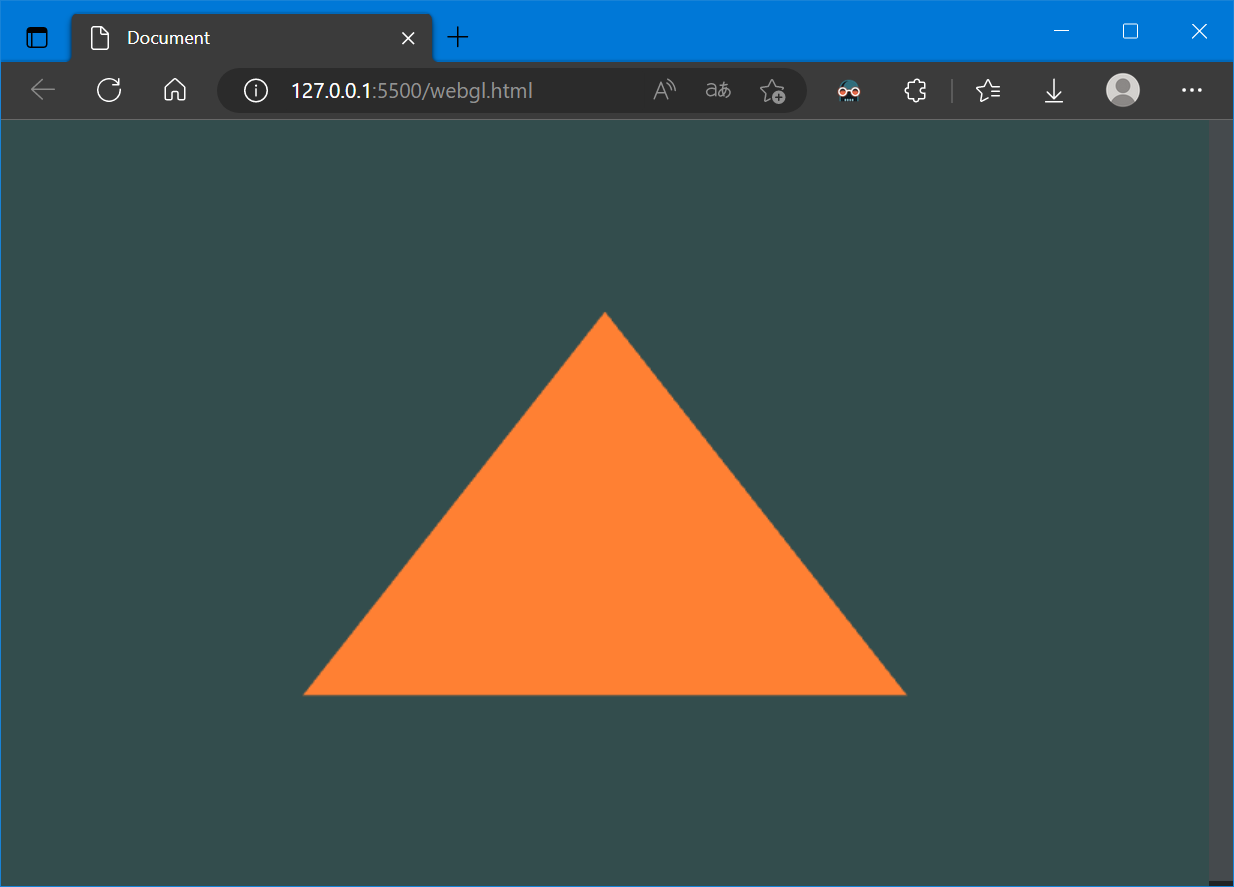1. 引言
Cesium是一款三维地球和地图可视化开源JavaScript库,使用WebGL来进行硬件加速图形,使用时不需要任何插件支持,基于Apache2.0许可的开源程序,可以免费用于商业和非商业用途
Cesium官网:Cesium: The Platform for 3D Geospatial
Cesium GitHub站点:CesiumGS/cesium: An open-source JavaScript library for world-class 3D globes and maps (github.com)
API文档:Index - Cesium Documentation
通过阅读源码,理清代码逻辑,有助于扩展与开发,笔者主要参考了以下两个系列的文章
渲染是前端可视化的核心,本文描述Cesium渲染模块的VAO
2. WebGL中的VAO
以下大致是一个最简的WebGL绘制代码:
<canvas id="canvas"></canvas>
<script>
const vertexSource = `
attribute vec3 aPos;
void main()
{
gl_Position = vec4(aPos.x, aPos.y, aPos.z, 1.0);
}
`
const fragmentSource = `
void main()
{
gl_FragColor = vec4(1.0, 0.5, 0.2, 1.0);
}
`
const canvas = document.getElementById('canvas');
canvas.width = canvas.clientWidth;
canvas.height = canvas.clientHeight;
const gl = canvas.getContext('webgl2');
if (!gl) {
alert('WebGL not supported');
}
const vertices = new Float32Array([
-0.5, -0.5, 0.0,
0.5, -0.5, 0.0,
0.0, 0.5, 0.0,
]);
const vbo = gl.createBuffer();
gl.bindBuffer(gl.ARRAY_BUFFER, vbo);
gl.bufferData(gl.ARRAY_BUFFER, vertices, gl.STATIC_DRAW);
const vao = gl.createVertexArray();
gl.bindVertexArray(vao);
gl.vertexAttribPointer(0, 3, gl.FLOAT, false, 0, 0);
gl.enableVertexAttribArray(0)
const vertexShader = gl.createShader(gl.VERTEX_SHADER);
gl.shaderSource(vertexShader, vertexSource);
gl.compileShader(vertexShader);
const fragmentShader = gl.createShader(gl.FRAGMENT_SHADER);
gl.shaderSource(fragmentShader, fragmentSource);
gl.compileShader(fragmentShader);
const shaderProgram = gl.createProgram();
gl.attachShader(shaderProgram, vertexShader);
gl.attachShader(shaderProgram, fragmentShader);
gl.linkProgram(shaderProgram);
gl.clearColor(0.2, 0.3, 0.3, 1.0);
gl.clear(gl.COLOR_BUFFER_BIT);
gl.useProgram(shaderProgram);
gl.drawArrays(gl.TRIANGLES, 0, 3);
</script>

其中,vao是顶点数组对象(Vertex Array Object, VAO),主要用来保存属性信息:
const vao = gl.createVertexArray();
gl.bindVertexArray(vao);
gl.vertexAttribPointer(0, 3, gl.FLOAT, false, 0, 0);
gl.enableVertexAttribArray(0)
WebGLVertexArrayObject接口是WebGL 2 API的一部分,顶点数组对象 (VAOs) 指向顶点数组数据,并提供不同顶点数据集合的名称
当使用WebGLVertexArrayObject对象时,这些方法会很有用:
示例代码中:
createVertexArray()方法创建并初始化(creates and initializes)一个 WebGLVertexArrayObject 的对象 (object) ,它代表一个指向顶点数组数据的顶点数组对象(vertex array object (VAO) ),并为不同的顶点数据集提供名称
bindVertexArray(target) 方法将给定的VAO绑定(后续对VBO的操作将会记录在绑定的这个VAO上),参数:
-
vertexArray
要绑定的
WebGLVertexArrayObject(VAO) 对象
vertexAttribPointer(index, size, type, normalized, stride, offset) 方法绑定当前绑定的Buffer到到当前顶点的通用顶点属性缓冲区对象(VAO)并指定其布局(告诉显卡从当前绑定的缓冲区(bindBuffer() 指定的缓冲区)中怎么读取顶点数据),参数:
-
index
GLuint(en-US) 指定要修改的顶点属性的索引 -
size
GLint(en-US) 指定每个顶点属性的组成数量,必须是 1,2,3 或 4 -
type
GLenum(en-US) 指定数组中每个元素的数据类型可能是:-
gl.BYTE: 有符号的 8 位整数,范围 [-128, 127] -
gl.SHORT: 有符号的 16 位整数,范围 [-32768, 32767] -
gl.UNSIGNED_BYTE: 无符号的 8 位整数,范围 [0, 255] -
gl.UNSIGNED_SHORT: u 无符号的 16 位整数,范围 [0, 65535] -
gl.FLOAT: 32 位 IEEE 标准的浮点数使用 WebGL2 版本的还可以使用以下值:
gl.HALF_FLOAT: 16-bit IEEE floating point number 16 位 IEEE 标准的浮点数
-
-
normalized
GLboolean(en-US) 当转换为浮点数时是否应该将整数数值归一化到特定的范围
对于类型gl.BYTE和gl.SHORT,如果是 true 则将值归一化为 [-1, 1]
对于类型gl.UNSIGNED_BYTE和gl.UNSIGNED_SHORT,如果是 true 则将值归一化为 [0, 1]
对于类型gl.FLOAT和gl.HALF_FLOAT,此参数无效
-
stride
一个
GLsizei(en-US),以字节为单位指定连续顶点属性开始之间的偏移量 (即数组中一行长度)。不能大于 255。如果 stride 为 0,则假定该属性是紧密打包的,即不交错属性,每个属性在一个单独的块中,下一个顶点的属性紧跟当前顶点之后 -
offset
GLintptr(en-US)指定顶点属性数组中第一部分的字节偏移量,必须是类型的字节长度的倍数
以上大致就是WebGL中vertex array object (VAO)的用法,需要注意,VAO对象在webgl2中才支持,在webgl1中是扩展的
3. Cesium中的VAO
Cesium中,对WebGL的VAO进行了封装:
function VertexArray(options) {
// ...
const context = options.context;
const gl = context._gl;
const attributes = options.attributes;
const indexBuffer = options.indexBuffer;
let vao;
vao = context.glCreateVertexArray();
context.glBindVertexArray(vao);
bind(gl, vaAttributes, indexBuffer);
context.glBindVertexArray(null);
}
创建一个VAO和VBO的例子:
// Example 1. Create a vertex array with vertices made up of three floating point
// values, e.g., a position, from a single vertex buffer. No index buffer is used.
const positionBuffer = Buffer.createVertexBuffer({
context : context,
sizeInBytes : 12,
usage : BufferUsage.STATIC_DRAW
});
const attributes = [
{
index : 0,
enabled : true,
vertexBuffer : positionBuffer,
componentsPerAttribute : 3,
componentDatatype : ComponentDatatype.FLOAT,
normalize : false,
offsetInBytes : 0,
strideInBytes : 0 // tightly packed
instanceDivisor : 0 // not instanced
}
];
const va = new VertexArray({
context : context,
attributes : attributes
});
创建一个VAO和两个VBO的例子:
// Example 2. Create a vertex array with vertices from two different vertex buffers.
// Each vertex has a three-component position and three-component normal.
const positionBuffer = Buffer.createVertexBuffer({
context : context,
sizeInBytes : 12,
usage : BufferUsage.STATIC_DRAW
});
const normalBuffer = Buffer.createVertexBuffer({
context : context,
sizeInBytes : 12,
usage : BufferUsage.STATIC_DRAW
});
const attributes = [
{
index : 0,
vertexBuffer : positionBuffer,
componentsPerAttribute : 3,
componentDatatype : ComponentDatatype.FLOAT
},
{
index : 1,
vertexBuffer : normalBuffer,
componentsPerAttribute : 3,
componentDatatype : ComponentDatatype.FLOAT
}
];
const va = new VertexArray({
context : context,
attributes : attributes
});
创建一个VAO与合并的两个VBO的例子:
// Example 3. Creates the same vertex layout as Example 2 using a single
// vertex buffer, instead of two.
const buffer = Buffer.createVertexBuffer({
context : context,
sizeInBytes : 24,
usage : BufferUsage.STATIC_DRAW
});
const attributes = [
{
vertexBuffer : buffer,
componentsPerAttribute : 3,
componentDatatype : ComponentDatatype.FLOAT,
offsetInBytes : 0,
strideInBytes : 24
},
{
vertexBuffer : buffer,
componentsPerAttribute : 3,
componentDatatype : ComponentDatatype.FLOAT,
normalize : true,
offsetInBytes : 12,
strideInBytes : 24
}
];
const va = new VertexArray({
context : context,
attributes : attributes
});
Cesium中的VAO还支持从Geometry创建:
// ...
// Create geometry with a position attribute and indexed lines.
const positions = new Float64Array([
0.0, 0.0, 0.0,
7500000.0, 0.0, 0.0,
0.0, 7500000.0, 0.0
]);
const geometry = new Cesium.Geometry({
attributes : {
position : new Cesium.GeometryAttribute({
componentDatatype : Cesium.ComponentDatatype.DOUBLE,
componentsPerAttribute : 3,
values : positions
})
},
indices : new Uint16Array([0, 1, 1, 2, 2, 0]),
primitiveType : Cesium.PrimitiveType.LINES,
boundingSphere : Cesium.BoundingSphere.fromVertices(positions)
});
// ...
// Example 1. Creates a vertex array for rendering a box. The default dynamic draw
// usage is used for the created vertex and index buffer. The attributes are not
// interleaved by default.
const geometry = new BoxGeometry();
const va = VertexArray.fromGeometry({
context : context,
geometry : geometry,
attributeLocations : GeometryPipeline.createAttributeLocations(geometry),
});
// Example 2. Creates a vertex array with interleaved attributes in a
// single vertex buffer. The vertex and index buffer have static draw usage.
const va = VertexArray.fromGeometry({
context : context,
geometry : geometry,
attributeLocations : GeometryPipeline.createAttributeLocations(geometry),
bufferUsage : BufferUsage.STATIC_DRAW,
interleave : true
});
在Cesium源码中创建VAO大多是直接使用构造函数,例如PolylineCollection.js:
const va = new VertexArray({
context: context,
attributes: attributes,
indexBuffer: indexBuffer,
});
此外,VertexArray封装的函数有:
function addAttribute(attributes, attribute, index, context)
function interleaveAttributes(attributes)
function setVertexAttribDivisor(vertexArray)
function setConstantAttributes(vertexArray, gl)
VertexArray.prototype._bind = function ()
VertexArray.prototype._unBind = function ()
VertexArray.prototype.isDestroyed = function ()
VertexArray.prototype.destroy = function ()
4. 参考资料
[1]WebGL2RenderingContext - Web API 接口参考 | MDN (mozilla.org)
[2]Cesium DrawCommand 不谈地球 画个三角形 - 四季留歌 - 博客园 (cnblogs.com)
[3]Cesium原理篇:6 Render模块(5: VAO&RenderState&Command) - fu*k - 博客园 (cnblogs.com)